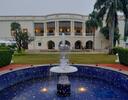Historical, Cultural Spiritual & Religious Journey of India
We take immense pleasure in designing an itinerary that is essence of India, an itinerary that is going to be in demand for years to come, an itinerary that covers the cultural, religious & spiritual dynamism of India, an itinerary that covers past & present of India … An itinerary that will give you an insight into Incredible land of India !
Delhi – Capital city of India which is a fusion of the ancient and the modern. Standing along the West End of Gangetic Plain, the capital city, Delhi, unwinds a picture rich with culture, architecture and human diversity, deep in history, monuments, museums, galleries, gardens and exotic shows
Agra – Agra widely known as ‘Wonder of Architecture' is one of the prominent destinations on the World Tourism map with three heritage monuments -The Taj Mahal, Agra Fort & Fatehpur Sikri. It is a vibrant centre of Culture, Art and Religious philosophies that have enriched mankind and shaped human thought over centuries
Lucknow – Sprinkled with Islamic and British Raj–era architecture, stuffed with fascinating bazaars and famed throughout India for its food, the capital of Uttar Pradesh is something of a sleeper: plenty worth seeing, but often overlooked by travelers. Central Lucknow features wide boulevards, epic monuments and several parks and gardens that contribute to an atmosphere of faded grandiosity.
Ayodhya – Ayodhya, located on the banks of river Sarayu is one of the seven sacred cities for Hindus. Ayodhya plays a critical role in the Hindu epic of Ramayana as it is the birthplace of Lord Rama. A grand Shri Ram Temple has been constructed & opened for worshipers & visitors in Jan. 2024.
Varanasi - Varanasi is the holiest city of the Hindu world, filled with temples and teeming with cultural life. In Varanasi, the Ganges river is considered a living goddess who is revered as Ganga Ma.
Gaya - The crucible of Buddhism, Bodhgaya was where Prince Siddhartha attained enlightenment beneath a bodhi tree 2600 years ago and became Buddha
Come ... Let's embark on this Historical, Spiritual & Religious Journey of India !
Itinerary
- Day 1
Arrival Delhi / Local sightseeing
Arrival Delhi
Upon arrival at Delhi airport, meet & greet by our representative and transfer to hotel enroute visit Qutab Minar
Qutub Minar - The soaring tower of the brick tiled magic, called Qutab Minar, has become synonymous with the colonial capital of Delhi. The majestic placard of sandstone pride is ubiquitous in Delhi, and you might find it everywhere; billboards, pamphlets, tatoos, tea stalls, truck tail pieces, and apparently, in the hearts of Delhites. Nestling in the southern quarters of lush Delhi, the 237.8 ft stately tower is an exquisite example of Indo-Islamic Afgan architecture
Welcome to Delhi, the capital and the third largest city of India which is a fusion of the ancient and the modern. Standing along the West End of Gangetic Plain, the capital city, Delhi, unwinds a picture rich with culture, architecture and human diversity, deep in history, monuments, museums, galleries, gardens and exotic shows
Later visit Rajghat, India Gate and Akshardham
Rajghat - Memorial to Mahatma Gandhi - The Raj Ghat is the last resting place of the Father of the Nation, Mahatma Gandhi. The last words uttered by Mahatma "Hey Ram" are inscribed near the black platform. An eternal flame keeps burning in a copper urn in the Raj Ghat
India Gate - Also known as the All India War Memorial, India Gate was built in the memory of 90,00 soldiers who laid down their lives during world war I. Enjoy the floodlit arch and the fountains nearby that seem magically lit up with coloured lights
Akshardham Temple - Lying in the wide-open 100 acres of land, amidst luxuriant lawns adorned with water fountains and carved pavilions, the temple complex stand imposingly on the banks of the serene River Yamuna. The temple showcases an amazing world of Indian culture through its ornate with 20,000 statues, floral motifs, arches and exceptionally carved pillars
Overnight at Delhi - Day 2
Delhi - Sightseeing
After breakfast, proceed for city tour
Visit Humayun Tomb, Red fort, Rickshaw ride, Delhi Haat
Humayun Tomb - Exemplifying the formative stage of the Mughal structural style, Humayun's Tomb stands as a landmark in the development of Mughal architecture, and also represents the earliest extent specimen of the Mughal scheme of the garden tomb, with causeways and channels. This building is traditionally culminated in the Taj Mahal, constructed a century later. Despite it being the first standardized example of this style
Red Fort - One of the most spectacular pieces of Mughal Architecture, fort sports all the obvious trappings befitting a vital centre of Mughal governance: halls of public and private audiences, domed and arched marble palaces, plush private apartments, a mosque, and elaborately designed garden
Rickshaw Ride - If you will ask Delhiites about the attractions of Old Delhi, most probably they will name the Red Fort, Qutab Minar, Chandni Chowk, but very few of them will tell about the rickshaw ride through the winding lanes of Chandni chowk
Delhi Haat - The Dilli Haat provides the ambience of a traditional Rural Haat or village market, but one suited for more contemporary needs. Here one sees a synthesis of crafts, food and cultural activity
Overnight at Delhi - Day 3
Delhi to Agra / Local sightseeing
After breakfast, drive to Agra [200 kms - 3 to 4 hours]
Agra widely known as ‘Wonder of Architecture' is one of the prominent destinations on the World Tourism map with three heritage monuments -The Taj Mahal, Agra Fort & Fatehpur Sikri. It is a vibrant centre of Culture, Art and Religious philosophies that have enriched mankind and shaped human thought over centuries
On arrival check in at hotel
Later proceed for visit Taj Mahal & Agra Fort
Taj Mahal - Standing majestically on the banks of River Yamuna, the Taj Mahal is synonymous with love and romance. The purity of the white marble, the exquisite ornamentation, precious gemstones used and its picturesque location, all make Taj Mahal one of the glorious wonders of the world
Agra Fort - Near the gardens of the Taj Mahal stands the important 16th-century Mughal monument known as the Red Fort of Agra. This powerful fortress of red sandstone encompasses, within its 2.5-km-long enclosure walls, the imperial city of the Mughal rulers. It comprises many fairy-tale palaces, such as the Jahangir Palace and the Khas Mahal, built by Shah Jahan; audience halls, such as the Diwan-i-Khas; and two very beautiful mosques
Overnight at Agra - Day 4
Agra to Lucknow / Local sightseeing
After breakfast, transfer to Lucknow [335 kms - 5 hours]
Lucknow
Sprinkled with Islamic and British Raj–era architecture, stuffed with fascinating bazaars and famed throughout India for its food, the capital of Uttar Pradesh is something of a sleeper: plenty worth seeing, but often overlooked by travelers. Central Lucknow features wide boulevards, epic monuments and several parks and gardens that contribute to an atmosphere of faded grandiosity.
The city rose to prominence as the home of the Nawabs of Avadh (Oudh), who were great patrons of the culinary and other arts, particularly dance and music. Lucknow’s reputation as a city of culture, gracious living and rich cuisine has continued to this day – the phrase for which conveniently rhymes in Nawab, Aadaab, Kebab & Shabab.
Check in at hotel on arrival
Later Lucknow sightseeing
Bara Imambara - This colossal imambara (tomb dedicated to a Shiite holy man) is worth seeing in its own right, but the highly unusual labyrinth of corridors inside its upper floors make a visit here particularly special. The complex is accessed through two enormous gateways that lead into a huge courtyard. On one side is an attractive mosque, on the other a large baori (step-well), which can be explored – bring a torch (flashlight).
Chota Imambara - This elaborate tomb was constructed by Mohammed Ali Shah (who is buried here, alongside his mother) in 1832. Adorned with calligraphy, it has a serene and intimate atmosphere. Mohammed’s silver throne and red crown can be seen here, as well as countless chandeliers and some brightly decorated tazia.
Rumi Darwaza - Just beyond the Bara Imambara, the striking Rumi Darwaza was built in the 1780s by Nawab Asaf-ud-Daula. It's unusual but imposing, and said to be a copy of an entrance gate in Istanbul. 'Rumi' (relating to Rome) is the term Muslims applied to Istanbul when it was still Byzantium, the capital of the Eastern Roman empire.
British Residency - The large collection of gardens and ruins that makes up the Residency offers a fascinating historical glimpse of the beginning of the end for the British Raj. Built in 1800, the Residency became the stage for the most dramatic events of the 1857 First War of Independence (Indian Uprising): the Siege of Lucknow, a 147-day siege that claimed the lives of thousands.
La Martiniere School - This prestigious boarding school – where British pop legend Sir Cliff Richard studied – was designed and built by Frenchman Major General Claude Martin as a palatial home. In 1800 it became his tomb: he's buried in the basement under a blue-washed spiral staircase.
State Museum - Houses sculptural masterpieces dating back to the 3rd century AD, including intricately carved Mathura sculptures ranging from dancing girls to scenes from the life of Buddha. Enter through the zoo.
Dilkusha Palace - Not Rome, not Athens, not Constantinople, not any city I have seen appears to me as striking and so beautiful as this. These lines about the city of Lucknow were written in March 1858 by William Howard Russell, the much travelled correspondent of The Times'.
Tomb of Sadat Ali Khan – Explore two prominent structures, the mausoleums of Nawab Saadat Ali Khan and his favourite wife Murshid Zadi. Hailed as an able administrator and builder, Saadat Ali Khan was the sixth Nawab Wazir of Awadh and the last to owe his allegiance to the Moghul King at Delhi. After his death on July 1,1814, his eldest living son Ghazi-ud-Din Haider took over as the Nawab Wazir.?
Over night at Lucknow - Day 5
Lucknow to Ayodhya / Visit Shri Ram Temple
After breakfast, depart for Ayodhya [135 kms. / 3 hrs. drive]
Ayodhya, located on the banks of river Sarayu in Uttar Pradesh, is one of the seven sacred cities for Hindus. Ayodhya plays a critical role in the Hindu epic of Ramayana as it is the birthplace of Lord Rama. This religious town is also the birthplace of four of Jainism's 24 Tirthankaras (religious teachers), beckoning tourists with its serene ghats.
With monkeys galore, the buzz of the visiting tourists, and a general spiritual aura, Ayodhya has been surrounded by controversy since about a decade now. It is the site of the 1992 Indian riots related to the Babri Masjid fiasco. The mosque, which was allegedly built on Ram Janmabhoomi Temple, became the bone of contention between Hindus and Muslims. In 2005, Ayodhya witnessed a terrorist attack at the site of Ramlalla Temple.
Despite the controversy, Ayodhya has so much colour and spirituality to see for its tourists and has emerged as a significant spiritual centre. The land of multi-faith temples, the traffic-free streets of Ayodhya are intriguing enough in itself to warrant a visit.
Check in at hotel on arrival
Later visit Shri Ram Temple
Ramjanma Bhoomi, Ayodhya
Translating to Ram's Birthplace, the Ram Janmabhoomi is believed to have been the birthplace of the Hindu deity, Lord Ram. According to the Indian epic Ramayan, Ram, Lord Vishnu's seventh manifestation, is said to have grown up along Ayodhya's river Sarayu. The Ram Janmabhoomi is a highly revered site for Hindu devotees.
After being a conflicted site for decades, the Ram Janmabhoomi land was handed over to a trust by the Supreme Court of India to build the Ram Temple. The groundbreaking ceremony for laying of the foundation stone for the Ram Temple of Ayodhya was performed on 5 August 2020 by Prime Minister Narendra Modi. The proposed design of the temple is grand and magnificent.
Overnight at Ayodhya - Day 6
Ayodhya - Prayagraj [Allahabad] - Varanasi
After breakfast, depart for Varanasi
Enroute visit Prayagraj [Allahabad] ... 170 kms., 4 hrs. drive
Prayagraj & Triveni Sangam
Brahma, the Hindu god of creation, is believed to have landed on earth in Prayagraj (or Allahabad as it was known until recently), and to have named it the king of all pilgrimage centres. Indeed, Sangam, a river confluence on the outskirts of the city, is the most celebrated of India’s four Kumbh Mela locations. The point of confluence is a sacred place for the Hindus, as it is of high religious importance to the Hindus. A bath here is said to wash all the sins and free human from the cycle of birth. The site of Sangam is a treat to the eyes. One can see the muddy and pale yellow water of Ganges merging with green water of Yamuna. The Ganges is only 4 ft deep, while Yamuna is 40 ft deep near the point of nexus. The river Yamuna ends at this point and Ganges continues after this till it meets sea at Bay of Bengal.
Continue drive to Varanasi ... 120 kms., 2 to 3 hrs. drive
Varanasi
Varanasi is the holiest city of the Hindu world, filled with temples and teeming with cultural life. In Varanasi, the Ganges river is considered a living goddess who is revered as Ganga Ma.
Without the river Varanasi would not exist as we know it. Considered as the abode of Lord Shiva, River Ganges is believed to have the power of washing away all of one's sins. As pundits here will tell you, whatever is sacrificed and chanted here or given in charity reaps its fruits thousand times more than those good deeds performed at other places because of the power of that place. It is believed that three nights of fasting in Varanasi city can reap you rewards of many thousands of lifetimes of asceticism!
Most visitors agree Varanasi is magical – but not for the faint-hearted. Intimate rituals of life and death take place in public, and the sights, sounds and smells on the ghats – not to mention almost constant attention from touts – can be intense. Still, the so-called City of Lights may turn out to be your favourite stop of all.
Check in at hotel
Overnight at Varanasi - Day 7
Varanasi sightseeing
Early morning Boat Ride on the Ganges
We rise before dawn and step gingerly in the boat as the boatman starts rowing the boat. We wait for the daily miracle to unfold, as the Sun appears triumphantly over the horizon. The sound of conches and temple bells add to the delicate pink fabric of dawn. The formerly hushed murmuring of ancient Sanskrit ‘Shlokas’ now rises, in one voice, to a crescendo of unparalleled piety and joy.
Back to hotel in time for breakfast
Later visit Kashi Vishwanath Temple
There are temples at almost every turn in Varanasi, but this is the most famous of the lot. It is dedicated to Vishveswara – Shiva as lord of the universe. The current temple was built in 1776 by Ahalya Bai of Indore; the 800kg of gold plating on the tower and dome was supplied by Maharaja Ranjit Singh of Lahore 50 years later.
Kashi Vishwanath Temple, is one of the 12 Jyotirlinga temples where Shiva is believed to have appeared as a column of light.
There were several earlier versions of the temple, possibly dating back more than a thousand years. The first recorded large-scale reconstruction was sanctioned by the Mughal emperor Akbar in 1585, but his great grandson Aurangzeb ordered its demolition in 1699 and used its debris for a new mosque near the site. The present structure, which is popularly known as the Golden Temple because of the gold used in the later plating of its spires and domes, is believed to have been built during the 18th century by Ahalya Bai of the Holkar dynasty.
According to Hinduism, visiting the Kashi Vishwanath Temple and bathing in the Ganges are important stages on the path to liberation, or moksha. Tens of thousands of pilgrims visit the temple daily. Every year during Mahashivaratri, a great procession takes place from the Mahamrityunjaya Temple to the Kashi Vishwanath Temple.
Evening Aarti
Ganga Aarti at Dasaswamedh ghat, close to Kashi Vishwanath Temple, is one of the prime attractions of Varanasi. It starts just after sunset, with a bunch of young men choreographing to the chantings, holding the lamps. People start arriving at the ghats as early as 5pm. Dasaswamedh ghat becomes a hub of activity, with people sitting and waiting for the aarti, buying flowers and other things from nearby shops or performing Pooja. It is conducted every sunset by five white-robed priests - These five young men sway in seemingly choreographed movements, worshiping the river goddess with incense, camphor, flowers and earthen lamps. Thousands of illuminated lamps are immersed in the waters of the holy Ganges and the floating lamps add a divine look to the river at dusk. Sit with some ‘sadhu’ and enjoy knowing their lifestyle from close proximity. You might even run into someone who is more than 100 years old! The Ghats also provide a good option for photography with serene temples and their bustling courtyards creating a perfect backdrop.
Overnight at Varanasi - Day 8
Varanasi sightseeing
After breakfast, explore the city of Varanasi offering many places of sightseeing ...
Banaras University, Kal Bhairav temple, Annapurna devi temple, Vishalakhi temple, Durga Temple, Sankat Mochan Temple, Manas Mandir, Mother India Temple, Sarnath, etc.
Darshan & City Tour of Varanasi
Varanasi being a centre for Hindu customs, temples form the main attraction. The Ganga Ghats (river fronts) are the main center of religious activities and rituals and also form one of the main attractions of Varanasi. Some of the most important temples of Varanasi are Durga temple, Vishwanath temple, Sankat Mochan temple, Tulsi Manas temple and the Bharat Mata temple.
The Alamgir Mosque, blend of the Hindu and Mughal styles of the architecture, is another important attraction of Varanasi.
Shopping at Varanasi
Varanasi is also visited for the wonderful shopping options that are offered ... holy water of Ganga or Ganga Jal, Banarasi silk sari, crystal & stone Shivlinga, glass beads, Rudraksha mala, Flutes, Sweets, Ramnami cloths to name a few
Sarnath - 10 kms. from city
Sarnath, about 10 km from the holy city of Varanasi, is the place where Buddha chose to deliver his first sermon. The celebrated Mantra, 'Buddham Sharanam Gachhami', owes its origin to Sarnath. On the day before his death Buddha included Sarnath along with Lumbini, Bodh Gaya and Kushinagar as the four places he thought to be sacred to his followers. It makes Sarnath one of the most venerated Buddhist places. Besides Buddhism, Sarnath is also connected with Jainism. There are many Buddhist monuments and edifices in Sarnath.
Some of the important Buddhist monuments at Sarnath are the Dhamekha stupa, the
Chaukhandi stupa and monasteries and temples of different schools of Buddhism from Japan, China, Thailand, Burma and others. The Indian Buddhist society called Mahabodhi Society maintains a park around the Buddha temple. The Mahabodhi Temple within the park has a tooth relic of the Buddha.
Places of Sightseeing at Sarnath
Chaukhandi Stupa - It is situated 13 kilometers away from Varanasi, is said to be built originally as a terraced temple in 4th to 6th century during the Gupta period. The Chaukhandi Stupa is a brick structure crowned with an octagonal tower. According to the famous Chinese traveller Hiuen-Tsang, this was the tallest stupa at that time in the region. The octagonal tower was added to the structure during the reign of the Mughal Emperor Akbar in 1588, to commemorate the refuge given to Humayun in Sarnath.
Ashoka Pillar - The Ashoka pillar of Sarnath is the National emblem of India.The great Mauryan emperor Ashoka built a series of pillars throughout India and some parts of modern Pakistan and Afganistan and the Sarnath Pillar is probably the grandest of all. In its original form the Sarnath pillar stood at 12.25 m, having a diameter of 0.71 m at the base and 0.56 at the top and a Lion Capital was placed at the top with four back to back lions. The famous Ashoka Chakra topped this structure. The Ashoka pillar was broken during Turk invasions. The Ashoka Pillar and the Lion Capital were discovered during excavations in 1904 at Sarnath. The excavators also found fragments of the Dharmachakra /Ashoka Chakra around the Ashoka pillar. The Ashoka Lion Capital is exhibited at the Sarnath Archaeological Museum. The wheel fragments have been mounted on the walls of the museum.
Sarnath Archaeological Museum - It just across the road near to Ashoka Pillar. The ASI museum at Sarnath is an on site museum and houses a number of artifacts related to Buddhist art as well as many images and sculptures of Hindu Gods recovered during excavations in the region. The museum comprises of five galleries with two verandahs. Some of the prominent artifacts at the musem include a life-sized image of a standing Bodhisattva, a panel depicting Shiva slaying Andhakasura, and the most important being the Lion Capital. Photography is not permitted inside the Sarnath museum, which may come as disappointment to many visitors.
Standing Buddha statue - The latest addition to many tourist attractions at Sarnath is the standing Buddha statue at the Thai Buddha vihar. With a height o 80 ft, it is the tallest standing Buddha statue. This magnificent statue of Buddha was built over 14 years as a result of Indo-Thai joint effort.
Overnight at Varanasi - Day 9
Varanasi to Gaya
After breakfast, depart for Gaya ... 250 kms., 6 hrs. drive
Gaya
The crucible of Buddhism, Bodhgaya was where Prince Siddhartha attained enlightenment beneath a bodhi tree 2600 years ago and became Buddha (the 'Awakened One'). In terms of blessedness, this tiny temple town is to Buddhists what Mecca is to Muslims. Unsurprisingly, it attracts thousands of pilgrims from around the world every year, who come for prayer, study and meditation.
The most hallowed spot in town is the bodhi tree that flourishes inside the Mahabodhi Temple complex, amid a beautiful garden setting, its roots embedded in the same soil as its celebrated ancestor. Additionally, many monasteries and temples dot the town, built in their national style by foreign Buddhist communities. The ambience is a mix of monastic tranquillity, backpacker comforts and small-town hustle, underpinned by an intensity of devotion that makes it endlessly interesting.
Check in at hotel on arrival
Later sightseeing of Gaya
Mahabodhi Temple - Built in the 6th century AD atop the site of a temple erected by Emperor Ashoka almost 800 years earlier, the Mahabodhi Temple was razed by foreign invaders in the 11th century, and subsequently underwent several major restorations. Pilgrims and visitors from all walks of life and religions come to worship or just soak up the atmosphere of this sacred place. An enthralling way to start or finish the day is to stroll around the inside of the perimeter of the temple compound (in an auspicious clockwise pattern) and watch a sea of white, maroon and yellow dip and rise, while Tibetan monks perform endless prostrations on their prayer boards. There’s a less atmospheric Meditation Park for those seeking extra solitude within the temple grounds.
Bodhi Tree - Known as Sri Maha Bodhi, the original tree was paid special attention by Ashoka, a mighty Indian emperor who ruled most of the subcontinent from 269 to 232 BC, a century or so after the date the Buddha is believed to have died. Ashoka's jealous wife, Tissarakkh?, felt the emperor should have been directing his devotion towards her, rather than towards a tree and, in a fit of rage, she caused the tree to perish by piercing it with poisonous thorns.
Great Buddha Statue - This 80ft-high Japanese-style statue of the Buddha seated in a lotus posture towers above a pleasant garden at the end of Temple St. The impressive monument was unveiled by the Dalai Lama in 1989 and is surrounded by 10 smaller sculptures of Buddha’s disciples. The statue is partially hollow and is said to contain some 20,000 bronze Buddhas.
Overnight at Gaya - Day 10
Departure from Gaya
After breakfast, morning at leisure
Later drop to airport for onward flight
Notes
Round the Year Destination ... Extension recommended to Amritsar & Khajurahoo
Hotels
Tour Inclusions - Best of Spiritual & Religious
5 nights accommodation
Breakfast at hotels
6 days AC transportation
Services of our expert guides at all locations during sightseeing – 2 days Varanasi, 1 day Allahabad, 1 day Ayodhya, 1 day Lucknow
Evening Aarti at the Ganges
Early morning boat ride on the Ganges
Notes on itinerary
All our itineraries are "Just for Ideas" ... We will get to know you and customise an itinerary just for you that matches your requirements ... dates of travel, category of hotels, preferred airline, flexibility in choosing sightseeing, mode of travel between cities, etc.
Many of our clients have us design more relaxing, slower paced holidays with more in-depth experiences whereas some simply want to visit various destinations and cover only the highlights.
Together, we will determine the ideal route, pace of travel, accommodations, levels of pampering, style of touring, sightseeing to be included, dining preferences, adventure levels, options to meet locals, dates of travel & much more ! and based on this arrive at a price.
Do feel free to get in touch with us by a quick call on +91 79 29602961 or a short mail on mail@destinations4india.com ... Looking forward




















